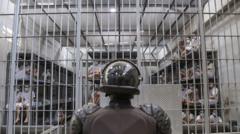The Trump administration has commenced the transfer of over 150 Venezuelan migrants to Guantánamo Bay, part of a broader plan to house up to 30,000 individuals, prompting scrutiny around legal and humanitarian implications of such actions.
Guantánamo Bay: New Migrant Holding Facility Under Trump's Plan

Guantánamo Bay: New Migrant Holding Facility Under Trump's Plan
The U.S. military base at Guantánamo Bay is being prepared to accommodate thousands of undocumented migrants, raising concerns about conditions and the legacy of indefinite detention.
In a striking policy shift, the Trump administration has begun relocating over 150 Venezuelan migrants from Texas to the U.S. military base at Guantánamo Bay, Cuba. These individuals, all reported to have final deportation orders, are part of a larger initiative to potentially house up to 30,000 undocumented migrants at the tightly monitored facility, historically known for its association with wartime detainees.
Affected groups have raised alarms about the implications of this move, especially considering Guantánamo Bay’s tumultuous history marked by indefinite detention and limited legal recourse. Satellite imagery has confirmed ongoing construction as the military prepares the camp site with tents for incoming migrants, signaling a systematic expansion of operations.
As of the latest reports, the military has stationed approximately 850 personnel, with over 700 being active service members, all focused on managing the potential influx. The circumstances surrounding which specific migrants were chosen for this transfer and the criteria used remain unclear, leading to questions about the administration’s migration policies.
President Trump’s directive on January 29 requested the Departments of Defense and Homeland Security to gear up for a significant increase in migrant capacity, heightening concerns among legal experts and human rights advocates about the fate of those housed in a facility known for its secretive practices.
Critics argue that the choice of Guantánamo for migrant detainment could reinforce the notion of a “legal black hole” where individuals might be left without clear paths to due process, further complicating the already tumultuous issue of U.S. immigration policy amid a growing global refugee crisis. The situation continues to develop as the administration works to define the future of migration processing at this controversial site.
Affected groups have raised alarms about the implications of this move, especially considering Guantánamo Bay’s tumultuous history marked by indefinite detention and limited legal recourse. Satellite imagery has confirmed ongoing construction as the military prepares the camp site with tents for incoming migrants, signaling a systematic expansion of operations.
As of the latest reports, the military has stationed approximately 850 personnel, with over 700 being active service members, all focused on managing the potential influx. The circumstances surrounding which specific migrants were chosen for this transfer and the criteria used remain unclear, leading to questions about the administration’s migration policies.
President Trump’s directive on January 29 requested the Departments of Defense and Homeland Security to gear up for a significant increase in migrant capacity, heightening concerns among legal experts and human rights advocates about the fate of those housed in a facility known for its secretive practices.
Critics argue that the choice of Guantánamo for migrant detainment could reinforce the notion of a “legal black hole” where individuals might be left without clear paths to due process, further complicating the already tumultuous issue of U.S. immigration policy amid a growing global refugee crisis. The situation continues to develop as the administration works to define the future of migration processing at this controversial site.





















